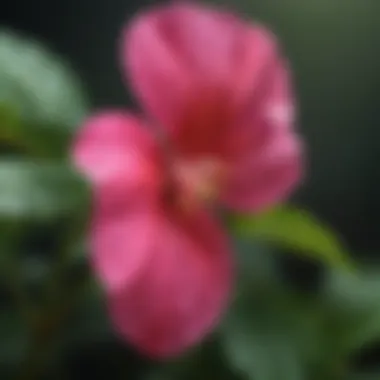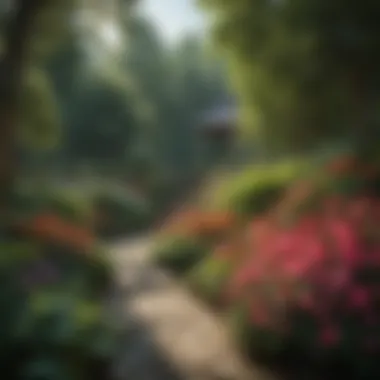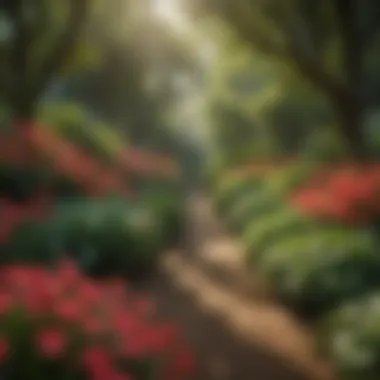Exploring the Vibrant Colors of Impatiens Flowers


Intro
The world of Impatiens flowers presents a remarkable array of colors that can transform any garden or landscape into a vibrant spectacle. This guide seeks to unravel the nuances of these captivating blooms, their cultivation methods, and the psychological impact of color in horticulture.
Understanding the significance of Impatiens, both in aesthetic terms and cultural lineage, enriches the gardening experience. This exploration will serve not only to inform gardening enthusiasts but also professionals in the field about the implications of color choices and practical care for these diverse species.
As we delve deeper, we will examine the unique attributes of various types of Impatiens, including their thriving preferences, care requirements, and how their colors can complement different settings. We will also consider the trends currently influencing the gardening world and the sustainable methods that can enhance the cultivation of these beautiful flowers.
The information presented here aims to foster a comprehensive understanding of Impatiens colors, making it a valuable resource for anyone looking to incorporate these beautiful flowers into their gardening practices.
Overview of Impatiens Species and Hybrids
Types of Impatiens
Impatiens are known for their rich variety, which includes both species and hybrids. Here, we explore some of the most popular types:
- Impatiens walleriana: Commonly referred to as the busy Lizzie, this species is a staple in many gardens due to its cheerful colors and adaptability.
- New Guinea Impatiens: These are hybrids known for their striking appearance and larger flowers. They are more shade-tolerant compared to other species.
- Impatiens balsamina: Known as the balsam flower, this species is celebrated for its double blooms and robust nature.
These species reflect the diverse palette that one can utilize in gardens, catering to various aesthetic preferences.
Characteristics of Impatiens Colors
The colors of Impatiens can range from soft pastels to vibrant hues, offering gardeners a broad spectrum to choose from. Each color carries its own significance:
- Pink often symbolizes affection and softness.
- Red stands for passion and energy.
- Purple is linked to royalty and luxury.
- White represents purity and simplicity.
Understanding these colors and their meanings can greatly influence planting choices and garden design.
"Color can change how we feel about a space, making Impatiens an excellent choice for impactful landscaping."
Cultivation of Impatiens
Environmental Preferences
Impatiens thrive in shaded or partially shaded areas, which makes them ideal for under trees or near structures. They prefer well-drained soil rich in organic matter. Understanding these environmental needs is critical for successful cultivation:
- Soil Type: Organic-rich soil promotes vigorous growth.
- Watering: Regular watering is essential, but over-saturation should be avoided as it leads to root rot.
Care Methods
Consistent care ensures healthy Impatiens plants:
- Fertilizing: Applying a balanced fertilizer every few weeks during the growing season promotes blossom longevity.
- Pest Control: Monitoring for pests like aphids and whiteflies is vital. Organic insecticides can be used as a first line of defense.
- Pruning: Trimming dead or damaged leaves helps maintain plant health and encourages new growth.
These practices enable one to maximize the visual impact of Impatiens in any garden.
Color Psychology in Gardening
Colors influence human emotions and perceptions. The choice of flower color can impact the ambiance of a garden. For instance, cooler tones like blue and purple can create a calm and serene environment, while warmer tones like orange and red can energize a space. Understanding color psychology can aid gardeners in making intentional choices that promote desired emotions in their outdoor environments.
Closure
This guide on Impatiens colors provides more than an understanding of plants; it inspires thoughtful methods of gardening, enhanced by color selection and cultivation practices. Through the principles discussed, both enthusiasts and professionals can elevate their landscaping endeavors while respecting sustainable practices.
For further reading on Impatiens and their impact in horticulture, consider exploring Wikipedia, Britannica for botanical insights, and reddit for community discussions.
Intro to Impatiens
Understanding Impatiens is crucial for both horticultural professionals and garden enthusiasts. This article aims to shed light on the unique aspects of this genus, focusing on its diverse colors and their practical applications in landscaping. Impatiens has become a staple in gardens around the world, admired for not only their beauty but also their adaptability.
Overview of the Genus
The genus Impatiens consists of over 1,000 species, primarily found in tropical and subtropical regions. They are known for their vibrant blooms and ability to thrive in partial shade. The most commonly recognized species include Impatiens walleriana and Impatiens hawkeri, among others. These species exhibit a vast range of flower colors, including pastel shades and vivid tones which makes them appealing for many different garden designs. Additionally, their soft foliage provides an excellent backdrop, further enhancing their decorative potential.
Zoning for Impatiens is particularly important. They prefer well-drained, rich soil and consistent moisture. This specific preference plays a significant role in their growth and flowering periods. When managed correctly, Impatiens can provide color throughout the growing season, making them an attractive choice for landscape aesthetics.


Cultural Significance
Impatiens have been significant in various cultures for centuries. They are often associated with vibrant gardens, symbolizing connection and vitality. In many Asian countries, the flowers are a common element in traditional celebrations and are used to convey blessings.
More recently, they have found their place in Western gardens as well. Their versatility makes them suitable for borders, containers, and mass plantings. The psychology of gardening also relates to how colors of flowers can evoke emotions; Impatiens in pink or red can energize a space while softer hues can induce tranquility.
"The color of plants significantly influences human emotions and perceptions, making the study of Impatiens vital in both landscaping and psychological contexts."
In summary, exploring the genus of Impatiens provides insight not only into their biological features but also into their cultural relevance and emotional impact on gardening experiences. Understanding these elements can enhance the appreciation and practical application of Impatiens in various settings.
The Spectrum of Impatiens Colours
The vast array of colours found in Impatiens flowers significantly enhances their appeal in landscaping and gardening. This section focuses on how colour diversity impacts choices for both aesthetic and functional purposes. Recognizing the colours available helps professionals in selecting the right types for specific design needs. The importance of colour in gardening extends beyond simple beauty; it influences mood, theme, and even plant compatibility.
Common Colour Variants
Pink
Pink Impatiens are commonly sought after for their soft and soothing appearance. Their delicate shade contributes to a tranquil garden atmosphere. Pink flowers can evoke feelings of calmness and harmony, making them a popular choice for serene garden spaces.
One unique feature of Pink Impatiens is their ability to blend well with most other colours. This characteristic allows for cohesive designs which is advantageous in landscape planning. Pink also tends to attract pollinators, thus benefiting the overall garden ecosystem.
Red
Red Impatiens are vibrant and striking, catching the eye with their bold presence. This colour plays a significant role in designing focal points within gardens. The high visibility of red makes it effective for drawing attention to specific areas.
Its unique characteristic is that it can signify passion and energy, which may change the feel of a space dramatically. However, the overwhelming nature of red can be a disadvantage in smaller gardens where a more subdued palette could be preferable.
White
White is often considered a classic choice in gardening, and White Impatiens validate this notion. Their clean and crisp appearance complements other shades, providing contrast and balance in different designs. White flowers can also brighten shaded areas, promoting a sense of openness.
In this article, the unique feature of White Impatiens is their versatility. They can fit into both contemporary and traditional styles, a beneficial quality for varying landscape aesthetics. However, they may require regular maintenance to keep their pristine look, which can be a drawback for some gardeners.
Purple
Purple Impatiens offer a rich and royal hue that appeals to many. This colour evokes a sense of luxury and elegance. It's often utilized in gardens aiming for a dramatic effect or a sophisticated vibe.
Their unique characteristic lies in their range of shades, from deep violet to soft lavender. This variability allows for creative expression in landscaping. However, they may not be as vibrant as other colours, losing some visibility in lush gardens.
Salmon
Salmon Impatiens provide a warm and inviting colour option. This variant stands out due to its blend of pink and orange hues. Its contribution to landscape design is profound, as it introduces warmth without being overpowering.
The unique feature of Salmon is its gradual gradient from pink to orange, which can create stunning combinations in floral arrangements. The main disadvantage may be its limited visibility in lower light settings, which could hinder its overall impact in shaded areas.
Rare and Unique Colours
Pastel Shades
Pastel shades of Impatiens represent a gentler colour palette offering a soft visual appeal. Their subtlety provides a unique contribution to a garden by fostering a relaxed ambiance. These shades often work well in shaded areas and allow for creative landscaping without overwhelming bold tones.
Their unique feature is the ability to pair beautifully with other pastel colours. This aspect is advantageous when employing a monochromatic theme in garden design. However, pastel colours can sometimes blend into the background, reducing their distinctiveness in a vibrant landscape.
Bi-coloured Variants
Bi-coloured Impatiens introduce an innovative twist on traditional colour choices. This variation allows for greater creativity in plant arrangements. Their blend of contrasting colours can create visual excitement and thematic diversity in gardens.
A unique feature is their ability to draw attention through their distinct patterns. However, one disadvantage may be the challenge of pairing them with other colours without clashing.
Novel Hybrids
Novel hybrids of Impatiens are a manifestation of advanced breeding techniques, giving rise to unique colours that were not previously available. Their presence enhances the diversity of choices available for gardeners. These hybrids can exhibit qualities such as increased resilience and colour stability.
Their unique characteristic is the potential for unique colour combinations that engage interest. However, novelty often comes with cost considerations, as these hybrids may be priced higher than standard varieties.


Understanding Colour Combinations
Complementary Colours
Understanding complementary colours is crucial when designing a garden with Impatiens. Complementary colours enhance one another's visibility and appeal, creating a balanced aesthetic. This knowledge is significant for professionals looking to maximize visual impact and harmony in their landscapes.
The unique feature is that complementary combinations create striking contrasts, which can make specific areas stand out. A disadvantage could arise when these combinations appear too bold, potentially overwhelming the observer in some instances.
Contrasting Palettes
Contrasting palettes take colour selection a step further by incorporating polarizing hues. This approach allows gardeners to create dynamic designs by juxtaposing colours that traditionally do not coexist. Such contrasts can draw the eye in various directions, creating an engaging visual experience.
The unique aspect of contrasting palettes is their capacity to highlight specific areas while offering depth. However, finding the right balance is crucial; if mismanaged, contrasts can indeed create chaos rather than elegance.
Cultivation of Impatiens
Understanding the cultivation of Impatiens is crucial for anyone looking to incorporate these vibrant flowers into their gardens. Proper cultivation ensures that these plants thrive, bringing their vivid colours to life and enhancing any landscape. Factors such as soil quality, environmental conditions, propagation techniques, and ongoing maintenance are fundamental to cultivate strong and healthy Impatiens.
Soil and Environmental Preferences
The choice of soil plays a vital role in the successful growth of Impatiens. These flowers prefer well-draining soil that is rich in organic matter. A pH range of 6.0 to 7.0 is ideal. Incorporating compost can improve soil fertility and structure. Additionally, Impatiens thrive in partial shade. Too much direct sunlight can lead to wilting and leaf burn. Hence, understanding the specific requirements for soil and light exposure is key for optimal growth.
Propagation Techniques
Propagation of Impatiens can be done through seeds or cuttings. Seed propagation is common but may require patience as germination can take time. On the other hand, taking cuttings offers a quicker route. Selecting a healthy shoot, cutting it just below a node, and placing it in water or soil can yield new plants. This method retains the desired traits of the parent plant, ensuring consistency in colour and growth habit. Choosing the right propagation method also depends on the available time and desired plant characteristics.
Care and Maintenance
Regular care and maintenance are essential for sustaining the beauty of Impatiens. Important aspects include watering, fertilisation, and pest management.
Watering
Watering is critical for maintaining the health of Impatiens. These plants require consistent moisture, as they are sensitive to both drought and overwatering. Watering should be done deeply yet infrequently to encourage deep root growth. A common practice is to check the soil with your finger; if it feels dry one inch deep, it is time to water. This method ensures that the plants remain hydrated without becoming waterlogged, which is crucial for preventing root rot.
Fertilisation
Fertilisers provide essential nutrients that boost the growth of Impatiens. A balanced, slow-release fertiliser, applied during the growing season, promotes lush foliage and vibrant blooms. Incorporating a liquid fertiliser every four to six weeks enhances flower production. However, caution is necessary. Over-fertilisation can lead to excessive leaf growth at the expense of flowers, which is an undesired outcome for many gardeners.
Pest Management
Effective pest management safeguards the health of Impatiens and maintains their aesthetic appeal. Common pests include aphids and spider mites. Regular inspections are important. Implementing integrated pest management strategies, such as introducing beneficial insects or using insecticidal soap, can mitigate infestations. Adopting these practices ensures longevity and health in your Impatiens, allowing them to thrive and flourish in any landscape.
"A diligent approach to care and maintenance can dramatically increase the lifespan and visual impact of Impatiens in any garden setting."
By considering these cultivation aspects, one can harness the full potential of Impatiens, creating a beautiful floral display that captures attention.
Aesthetic Applications in Landscaping
The incorporation of Impatiens into landscape design is a practice that accounts for both the beauty and functionality of these flowering plants. Their vibrant colors and distinctive foliage allow for creative landscaping solutions. When utilized effectively, Impatiens can transform typical outdoor spaces into visually engaging environments.
Design Principles Using Impatiens
When designing with Impatiens, several principles can guide the process. First, consider the color palette. Impatiens come in a variety of shades including pink, red, white, and purple. Selecting colors that harmonize well with each other and with the surrounding environment enhances the overall aesthetic. For instance, pairing bright pink Impatiens with softer white flowers can develop a layered visual impact.
Next, think about the scale and proportion of the plants. Impatiens are typically used in mass plantings or as focal points. A large bed of red Impatiens can act as a vibrant centerpiece, drawing the eye effectively. Conversely, smaller clusters can provide subtle accents in a more intricate design.
Finally, plan for seasonal transitions. While Impatiens thrive during warm months, considering companion plants that can take center stage during their dormancy can ensure year-round visual interest in the landscape.
Impatiens as Ground Cover
Utilizing Impatiens as ground cover provides numerous benefits. Their dense foliage effectively suppresses weeds, reducing maintenance efforts. This feature is particularly advantageous in shaded areas where grass struggles to grow.
By selecting certain color variants, one can create stunning visual carpets across gardens or alongside pathways. These colorful expanses can soften hard edges in landscape designs, facilitating a gentler transition between diverse elements. Furthermore, their adaptability means they can thrive in various soil types, making them a reliable choice for many landscaping projects.
Container Gardening with Impatiens


Container gardening with Impatiens serves as an excellent way to display their colors in smaller spaces. This method allows for flexibility in design and placement. Containers can be arranged on decks, patios, or balconies, bringing life to otherwise stark areas.
When choosing containers, consider the material and size. Terracotta, plastic, and ceramic pots can complement Impatiens well. Ensure the pot size is appropriate to allow for root growth while also considering drainage. Proper drainage is crucial, as Impatiens do not respond well to standing water.
It is important to maintain a consistent watering schedule. Impatiens thrive in moist but not soggy conditions. Regular checks of the soil's moisture level can guide watering needs. Additionally, remember to incorporate fertilizers formulated for container plants. This will support vibrant blooms and robust growth throughout the flowering season.
"Impatiens are not just humble blooms; they transform spaces and evoke emotions, making them essential in the art of landscaping."
In summary, the aesthetic applications of Impatiens in landscaping are vast. Whether creating serene ground cover or using containers to enhance small spaces, these plants offer unique opportunities for vibrancy and design. Through thoughtful color selection and understanding their environmental needs, landscape designers can unlock the full potential of Impatiens in their projects.
The Psychology of Colour in Gardening
The role of colour in gardening extends far beyond mere aesthetic appeal. Understanding the psychology of colour can significantly enhance the impact of a garden space, especially when working with flowers such as Impatiens. This section will discuss how colour choices can influence emotions and perceptions, and how cultural interpretations further shape these experiences. By exploring these elements, horticulturalists can create an atmosphere that promotes specific responses, ultimately enriching the gardening experience.
Emotional Responses to Colour
Different colours evoke varied emotional responses, and this is particularly relevant in gardening. For example, red typically connotes passion and energy, while blue often imparts calmness and tranquility. Impatiens, with their wide spectrum of colours, can be strategically employed to elicit desired feelings in a garden setting. By selecting colours that resonate emotionally with intended users, the gardener can transform a simple planting into a powerful emotional landscape.
Key Emotional Responses
- Red: Invokes passion, excitement, and warmth.
- Blue: Creates a sense of serenity, trust, and relaxation.
- Yellow: Represents happiness, optimism, and cheerfulness.
- Green: Evokes nature, growth, and freshness.
- Purple: Suggests sophistication, mystery, and creativity.
For instance, a combination of pink and white Impatiens can create a soothing environment, ideal for relaxation areas. In contrast, vibrant red Impatiens can energise spaces intended for social interactions.
"Colour is the touch of the senses; it brings emotions into play. In gardening, this means that each shade we select can resonate with the mood we wish to convey."
Cultural Interpretations of Colour
The meanings associated with colours are not universal; they can vary significantly across cultures. For instance, while white is often viewed as a symbol of purity in Western cultures, it is associated with mourning in some Eastern traditions. This aspect of colour psychology is essential to consider when planning a garden that may be experienced by a diverse audience.
Here are some cultural interpretations of common colours:
- Red: Often symbolizes good fortune and happiness in Asian cultures, while it can represent danger or caution elsewhere.
- Yellow: In many Western societies, yellow is bright and cheerful, but in some regions, it is a symbol of jealousy or deceit.
- Green: Universally associated with nature, but it also has meanings linked to renewal and life in many cultures.
- Blue: Often related to tranquility and peace across various cultures, it can also signify depth and stability.
- Purple: Historically linked to royalty, it denotes luxury and power in many societies.
By understanding these cultural contexts, gardeners can make informed choices that not only appeal to aesthetic preferences but also respect and reflect the diverse meanings of colour across different cultures. This is particularly salient when working in public gardens or shared spaces where plants are viewed by people from varied backgrounds.
In summary, the psychology of colour in gardening demands attention from designers and horticulturists alike. By carefully selecting colours based on emotional responses and cultural significance, one can create landscapes that are not only beautiful but also culturally sensitive and emotionally resonant.
Current Trends in Impatiens Cultivation
The world of gardening is in constant evolution. Impatiens, a popular choice for many gardeners, mirror these trends. Understanding the latest developments in impatiens cultivation provides insights into their care and aesthetic potential. Two primary trends stand out: innovative breeding techniques and sustainable practices. These trends not only enhance aesthetics but also contribute positively to environmental considerations.
Innovative Breeding Techniques
Breeders are increasingly focused on enhancing the genetic diversity of impatiens. This comes in response to various challenges in cultivation, such as disease resistance and climate adaptability. Recent advancements include cross-breeding various species, leading to hybrids that offer more robust features.
- Disease Resistance: New strains are being developed to withstand common afflictions like downy mildew. This is crucial, as previous outbreaks have significantly impacted growers.
- Color Variability: Breeding aims to produce unique color variations. This allows gardeners to experiment with their landscapes using a more diverse palette.
- Growth Characteristics: Breeding also focuses on creating plants that offer extended blooming periods and enhanced durability in various conditions.
These innovative approaches are reshaping how impatiens are integrated into garden designs.
Sustainable Practices in Cultivation
Sustainability is a major consideration in current cultivation practices. As environmental concerns rise, gardeners are adopting methods that reduce their ecological footprint.
- Organic Fertilizers: The use of organic materials for nourishment is becoming prevalent. This encourages healthier soil without introducing harmful chemicals.
- Water Conservation: New irrigation technologies help optimize water use. Systems like drip irrigation reduce waste and ensure that plants receive adequate moisture without excess runoff.
- Native Integration: There’s a growing focus on integrating impatiens into local ecosystems. This practice enhances biodiversity while reducing the need for chemical treatments.
Implementing sustainable practices leads not only to healthier plants but also to a healthier environment. Such methods are increasingly crucial as we face changing climate conditions.
"Adopting sustainable gardening practices encourages the longevity of plant species while promoting ecological health."
End
In this comprehensive guide, we have explored the multifaceted world of Impatiens colours, dissecting their significance in both horticulture and landscaping. Understanding the various hues of Impatiens is not merely about aesthetics, but also involves deeper implications on psychological effects and cultural meanings assigned to these plants.
The rich spectrum of colours found in Impatiens, from traditional pinks and reds to the more elusive bi-coloured variants, showcases the versatility of these flowers. This versatility allows gardeners and landscape designers to create visually compelling spaces that resonate with the emotional and psychological desires of individuals.
Moreover, the current trends in cultivation emphasize sustainability and innovative breeding techniques. These developments reflect a growing awareness of environmental impacts within horticulture. By integrating sustainable practices, cultivators can ensure that Impatiens not only flourish aesthetically but also contribute to eco-friendliness in garden design.
Looking closely at the future of Impatiens research brings forth various elements worth considering. As we delve into the genetics of colour variation and the potential for new hybrids, it becomes apparent that the future holds much promise. Additionally, understanding how these developments can meet the evolving preferences of gardeners and consumers is crucial.
"The study of Impatiens is more than just a seasonal pastime; it's a pathway to understanding human behaviour in relation to nature's palette."
In summary, the future directions in Impatiens research will play a vital role in shaping how these flowers are perceived and utilized in the gardening world. Careful consideration of both the aesthetic and the ecological aspects will undoubtedly enhance not only the visual appeal but also the sustainability practices in this field.







